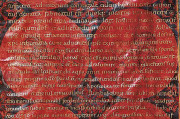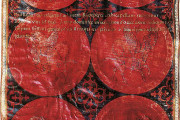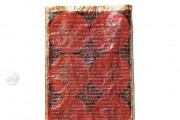The Marriage Document of Empress Theophano outlines the terms of the marriage of the young Theophano to Holy Roman Emperor Otto II in Rome on 14 April 972. Otto was at the time ruling as co-emperor with his father, Otto I, who would die the following year. A monument of Ottonian painting in roll form, the document is supremely significant as one of the oldest documents most probably from the personal archive of a woman reigning at the highest political level.
The document is written in Latin on three pieces of parchment painted to form a tall, thin roll. Penned in precious gold, the sixty-two lines of the text focus on the dower—the ultimate financial provision—to Theophano in her marriage to Otto. In addition to outlining the young bride's extensive endowments, the text also emphasizes the spiritual importance of marriage.
In Imitation of Byzantine Textiles
The roll simulates the look of Byzantine silk with decorative "embroidered" edging in gold, blue, and white. At the top, it commences with a golden strip containing seven small medallions with busts of Christ, the Virgin, and John the Evangelist flanked by four additional prophets or apostles.
The final 23 cm of the roll is free of text, allowing unimpeded viewing of the purple medallions and interstices of blue featuring stylized foliage. The two columns of large medallions feature animal pairings that alternate between lions with their paws around bulls (?)—as if riding them—and griffins in a similar "embrace" with deer (?).
The face (front) of the document has a ground painted in minium (red lead) and madder (a red dye from the root of the madder plant), and—to a lesser degree—indigo. The paired animals are painted in glazes on top of this ground and under the gold writing.
Written in Gold
This document is significant as an exquisite example of chrysography (writing in gold). Its content adheres to the fixed formula of a document of the time.
It begins with an invocatio (invocation of the Trinity) and an intitulatio (naming Otto as emperor). There follow the arenga (a theological discussion of the holiness of marriage) and the promulgatio (the statement of Otto's decision to marry Theophano and to make her co-regent). The legal content, the disposatio, comes next: this outlines Theophano's endowment. The document concludes with the eschatol (names and signatures and the date and site of the agreement).
Its handsome script is heralded as one of the finest representations of Caroline Minuscule and has been attributed to the Master of the Registrum Gregorii, an illuminator and scribe active in Trier and other centers in the Ottonian Empire. The minuscule is used for the majority of the document, save for the invocatio and intitulatio (lines 1-2) and the names of the pope and the imperial persons, which are written in elegant Rustic Capitals.
Imperial Convent of Gandersheim
Theophano herself is believed to have deposited the certificate at the house of canonesses at Gandersheim for safekeeping. The female intellectual center was a frequented refuge for the young empress and was the birthplace or nursery of two of her children.
The survival of the document is to be credited to the careful stewardship of the Gandersheim community. After the secularization of Gandersheim in 1811, the document enjoyed brief sojourns in the then Universitätsbibliothek Göttingen and in Braunschweig, before being transferred to Wolfenbüttel in 1835.
We have 1 facsimile edition of the manuscript "Marriage Document of the Empress Theophano": Die Heiratsurkunde der Kaiserin Theophanu facsimile edition, published by Mueller & Schindler, 1980
Request Info / Price



